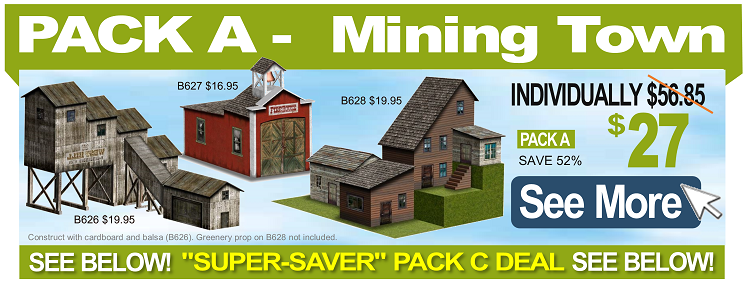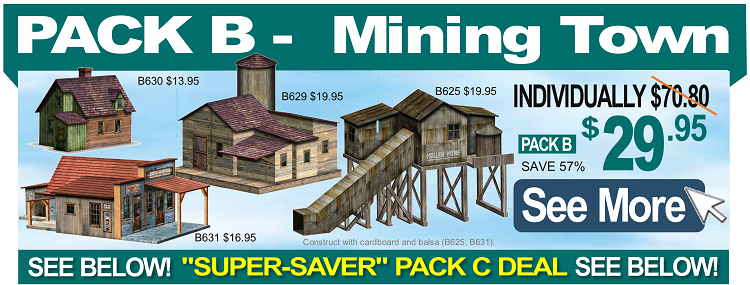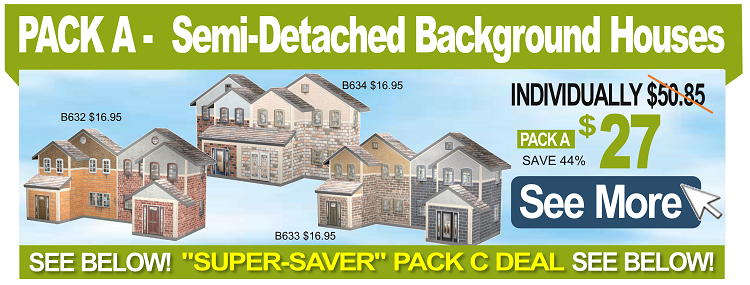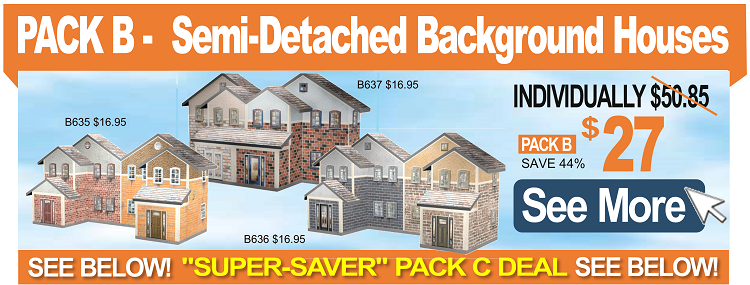FREE CATALOGS!
Download Your Free Model Buildings Catalog Today…
to keep as a Handy Reference
on Your Computer, or Beside Your Model Railroad.
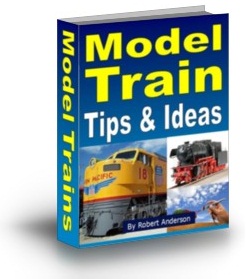
Creating a Believable Backdrop for Your Model Trains
Practically everybody with a model railroad be it a simple shelf layout, or an around-the-room “wall hugging” design will require some sort of backdrop to add interest to the scenic landscape so as to develop a complete life-like scene in which to showcase and operate their trains. No doubt you are no different?
Even a simple freestanding tabletop design will likely have sides, or a middle divider to provide the look and feel that the trains are running long distances, even though in reality the track might only be a few feet in length.
[expander_maker id=”2″ more=”Load more” less=”Load less”]
The design and construction of a basic background is not as overwhelming as it may appear, despite the fact that it might require a little thought, time, and effort to get it looking just right. Download a copy of the free model buildings catalog on this page.
Smoothing out the room corners
For a layout that hugs the wall, one of the principal things to consider is whether you need to conceal the edges of the room by one means or another. All things considered, room corners are usually sharp right angles so don’t look very realistic if you are trying to achieve a naturally flowing scene. Using thin sheets of hardboard to turn the corners of the wall into gentle curves is one way to overcome the problem. Thin hardboard is generally easy to bend and fasten and glue in place. The hardboard can be used along the entirety of the backdrop. After attaching the hardboard behind the layout, you can use some drywall tape a sealing compound to cover the joins and any screw holes. After it is dried you won’t be able to spot the joins, especially after it has been painted or covered with a photographic backdrop. A copy of the free model buildings catalog is available here.
Painting the sky background
If you are going to paint the sky rather than use photographic images, then this can be achieved reasonably simply without the need for to much creative ability. Obviously the more artistic you are the better the result is likely to be.
Buy some acrylic paint – white and a sky blue color. A paint roller can be used to paint the upper half of the backdrop sky blue. Before the paint dries, start blending some white paint into the lower part of the sky blue paint. Work your brush using horizontal brush strokes. The further you move down, the more white you blend in, but don’t use pure white. Pre-mixing some lighter shades of blue in a separate paint tray might help give a better result. Gradually blend in the colors as well as you are able, but try not to make it too perfect as it could look unnatural. Little streaks of the white mixed in with the blue tones will give the impression of small wisps of low-lying clouds floating in the distance. Other sections of the layout backdrop can be painted using the same method, all the way around the wall until the sky is all done. If you are proficient with an airbrush then use that to add some really subtle tones. Get your free model buildings catalog showing the very comprehensive library of downloads for paper models – HO scale – N scale – OO scale..
Painting clouds
When everything is dry you can add a few clouds in various places using a light (or medium) gray paint towards the base of the clouds before blending in white color paint as you move further up the cloud. To make each cloud appear fluffy with an irregular pattern you can apply a stippling effect using a brush with a tiny amount of white paint. There is a bit of an art to this technique, but you’ll soon master it by practicing on a scrap piece of cardboard. If you go to Google Images you get plenty of reference photos of clouds to guide you. If you add too many clouds against the sky if might detract from your layout. The aim is to simply create the impression of a realistic sky horizon. Your trains need to be the “hero” and focal point, not the sky or clouds. Get a free catalog showing the range of paper model buildings. The catalog is free to download.
Mountains in the background
Depending on the scene, how creative you want to be, or how three dimensional you want your backdrop to look; you could apply some flat yet muted colors of green-gray or blue-gray to give the impression of distant mountains near the base of the horizon. It’s probably best not to add too much detail, because the idea is to just give a vague impression of hills or mountains in the distance to add a further dimension and create the perfect setting for your model trains. Grab your free model buildings catalog today.
Whenever you are painting backdrops always be aware of the position of the sun in relation to the mountains and clouds. Light from the sun wouldn’t normally show on both sides of the mountains. A lighter color paint blend can be used towards the edges of the mountains to blend in to the darker color paint on the opposite side of the mountains shaded from light. The effectiveness will depend on how proficient you are at blending color and tones. A separate mixing tray is a useful tool, and it might just be a case of blending a tiny amount of white or yellow paint to the color you’ve applied to the mountains to lighten the edges. That scrap piece of cardboard I mentioned earlier will be useful for testing your blending and mixing skills before applying the lighter color to the background mountains.
Depending on the type of scene and how intricate you want to make it, you could paint some grassed fields, or some trees and bushes, or simulate the shapes of distant structures, perhaps a forest or city off towards the horizon. Again, some photos from Google Images might be of help. Download your copy of our free model buildings catalog today.
Using pre-printed backdrop scenery
Another popular option is to buy rolls or sheets of photographic murals for your background scenery. Various companies supply it online. Depending on what you purchase, you might need to join some sections together to create a long and continuous scene. The main thing is to ensure the joins are invisible or disguised in some way. Positioning the “low-relief” structures available on this webpage will add a realistic 3D effect and bring life and perspective to your layout.
Bringing it all together
Hopefully these ideas have been helpful in creating your backdrop scenery. The key point to always remember regardless of the nature of scene you use for your railroad backdrop, strive to blend in the foreground scenery so it matches the background scene as closely as you can. The foreground scenery shouldn’t just suddenly stop for the background scenery to begin. Anyone viewing your layout should view the scene as one, and not as two parts put together, so it should be hard to distinguish where the front scenery finishes and where the backdrop begins. Remember to download a copy of the free model buildings catalog from this web page.
[/expander_maker]

